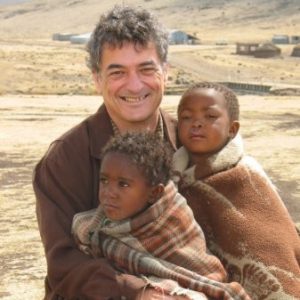As part of Hispanic Heritage Month recognized during September 15 through October 15, CALS is showcasing its students, faculty, and alumni who research topics of importance to Latin America.
 Gustavo Alberto da Fonseca, an alumnus from the UF/IFAS College of Agricultural and Life Sciences, is a world-renown ecological scholar and key figure in biodiversity conservation. He earned a Ph.D. in forest resources and conservation with a focus on wildlife ecology and conservation in 1988. He also holds a master’s degree in Latin American studies from UF.
Gustavo Alberto da Fonseca, an alumnus from the UF/IFAS College of Agricultural and Life Sciences, is a world-renown ecological scholar and key figure in biodiversity conservation. He earned a Ph.D. in forest resources and conservation with a focus on wildlife ecology and conservation in 1988. He also holds a master’s degree in Latin American studies from UF.
Most recently, Fonseca was presented with the Distinguished Alumnus Award by the University of Florida at the 2017 fall graduation ceremony. The award is one of the highest honors bestowed upon a graduate of the university and recognizes recipients who have excelled in their chosen field or have performed outstanding service for the university. Fonseca was able to share some words of wisdom for current and future CALS students as we celebrate Hispanic Heritage Month.
1. What first sparked your passion for wildlife management and conservation?
I grew up in Brasilia, the city that was carved out from the heart of the Cerrado ecosystem in Brazil, basically from nothing but nature. It was there that I was able to appreciate nature first-hand and initiate my studies, still at the undergraduate level, doing research on primate ecology and behavior.
2. What is your biggest piece of advice that you would give to a student who may have similar ambitions as you do?
Don’t overplan your career. Work as hard as you can. Always pursue your core interests; let them evolve, shift and expand, and things will happen. Take risks. Follow your heart.
3. How were you able to bring science and conservation together?
The interlinkages between science and field conservation come to you naturally. The important aspect is that you let science take precedence over its application in the real world. Science informs policy, not the other way around. But science alone is sterile. Resist the confines of the ivory tower.
4. What has been your most impactful finding throughout your years working with ecology?
The most important realization was of a personal nature – through the epiphany that came from having been trained as a biologist. This training eventually helped me to more effectively navigate in society and in dealing with people. My understanding of human societies was sharpened by my being exposed to the social sciences during my graduate work at UF, but biology still drives much of how people behave – however arrogant this may sound. Since a significant part of conservation entails changing human behavior, biology becomes a huge asset. In that, I am a fan of E. O. Wilson [an American biologist, theorist, naturalist, and author].
5. What brought you to the UF/IFAS wildlife ecology and conservation department and the Latin American Studies unit?
The answer is simple. I had a professor at the University of Brasilia – Dr. Cleber Alho – from where I received my undergraduate degree. Dr. Alho went to graduate school together with Dr. John G. Robinson at the University of North Carolina at Chapel Hill. Dr. Robinson, in turn, came to UF to start the “Program for Studies in Tropical Conservation”, one of the precursors of the Tropical Conservation and Development Program (in the UF Center for Latin American Studies). John asked Cleber if he had any students he would like to recommend for the program, and Cleber gave me a call. The rest is history.
6. What was it like serving as a professor at the Federal University of Minas Gerais in Brazil?
I love that university, the students, faculty, and the administration. I enjoyed every moment of my time as a faculty of UFMG, and I am grateful it gave me and my colleagues the right conditions and stimulus to create the Graduate Program in Ecology, Conservation and Wildlife Management, that has now graduated more than 500 masters and Ph.D. students.
7. What was your personal mission while working at the Conservation International (CI) in Brazil?
Science and conservation need to go hand-in-hand. CI-Brasil started at my lab at UFMG, where my graduate students had the opportunity to also be exposed to real conservation on the ground. CI’s original mission was to translate the most robust and up-to-date science into biodiversity conservation action. In this, it was exceedingly successful.
8. What has been your favorite study that you have conducted as a leader in the fields of ecology and biodiversity conservation?
Perhaps when I joined with Norman Myers, Russ Mittermeier, and others in broadening the concept of Global Biodiversity Hotspots. In addition to generating several high-profile papers, this work was tremendously influential in the conservation field and in guiding funding to the biologically richest and most threatened regions of the world. This work also ended up guiding the investments of the Global Environment Facility – the single largest donor to biodiversity conservation – where I am today.
9. What are your goals for the future?
I make no plans. I let life take me where I need to be.
10. What has been most rewarding about your career?
As most people would agree, it was the opportunity to visit and work in over 60 countries, be exposed to different cultures, and understand this small planet better.
 0
0
